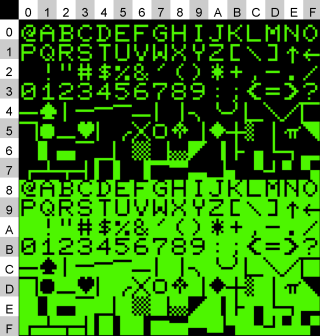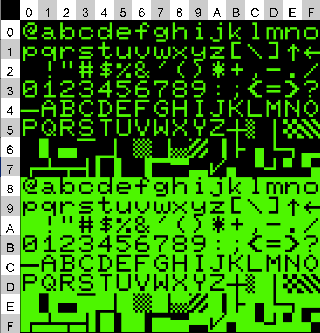

6502 Assembly programming for the Commodore PET
| The PET was the predecessor to the
VIC 20, Released in 1976 it was the earliest of the Commodore home
computers Later revisions added more memory and a higher screen resolution, though it was still only 'character based'
|
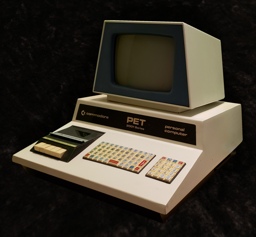 Thanks to "KnightFire66" for the PET photos! |
Useful Documents
Quick Reference
The Pet Revealed
ChibiAkumas Tutorials
Lesson
H10 - Hello World on the Commodore PET
Lesson
S32 - Char Block clipping on the Commodore PET!
Lesson S19 -
Keypad Reading on the Commodore PET!
Lesson
P38 - Character Block Graphics on the Pet
Lesson
P39 - Key reading on the PET
Lesson
P40 - Sound on the PET
Lesson
P49 - Sound on the Commodore PET (ChibiSound Pro)
Lesson
P63 - Multiplatform Software tilemap on the PET
Memory Map
| From | To | Function |
| $0000 | $3FF | OS and Basic storage |
| $0400 | $1FFF | Basic Program / 8k main ram |
| $2000 | $7FFF | 32k extension |
| $8000 | $83FF | VRAM |
| $C000 | $E7FF | Basic ROM |
| $E800 | $EFFF | I/O |
| $F000
|
$FFFF
|
OS ROM |
Interrupt vectors
The standard 6502 interrupt vectors from $FFFA+ are ROM, however these jump to vectors in low memory addresses. IRQ and BRK interrupts push A,X and Y onto the stack in that order.
Immediately after the pushes, the interrupt handler at the addresses below are executed.
VBLank interrupts cause a CB1 IRQ interrupt. This can be disabled with "lda #%11111100 sta $e813"
Note: The vector addresses were different on the first generation 2001-8 machine.
| 2001-8 | Others | ||||
| From | To | From | To | Function | Registers Pushed |
| $0219
|
$021A | $0090 | $0091 | IRQ | A X Y |
| $021B | $021C | $0092 | $0093 | BRK | A X Y |
| None | None | $0094 | #0095 | NMI | |
Character Map
| Write #12 to $E84C
|
Write #14 to $E84C
|
Keymap
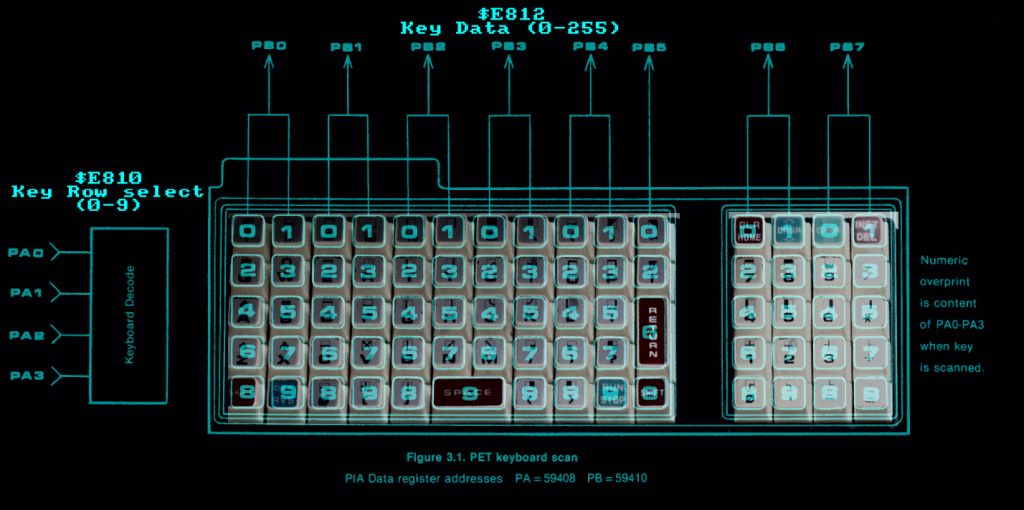
Rom Functions
| Address | Purpose |
| $FFD2 | PrintChar A |
| $FFE4 | ReadChar A |
| $FFCF | Input a character |
I/O Map
| Port | Purpose | Bits | Notes |
| $E810 | PIA1:Key Row select (0-9) | DICcKKKK | D=Diagnostic sense / I=IEEE EOI in / C=Cassette sense #2 / c==Cassette sense #1 / K=Keyboard Row select |
| $E811 | PIA1:Screen / Tape | T-SSSDCC | T=Tape #1 input flag / S = Screen blank (old 8k only) IEE EOI Out CA2 / D=DDRA Access (Data Direction Reg A) / C=Casette #1 read control CA1 |
| $E812 | PIA1:Key Data | KKKKKKKK | K=Keyboard Row Input |
| $E813 | PIA1:Screen / Tape | R-CCCDrr | R=Retrace I
flag / C=Cassette #1 Motor output CB2 / D=DDRB Access (Data
Direction Reg B) / r= retrace interrupt control CB1 (rr=1
Vblank interrupt) |
| $E820 | PIA2:IEEE488 Input | IIIIIIII | I=IEEE Input |
| $E821 | PIA2:IEEE488 | A-INCDia | A=ATN I Flag / I=IEEE/ N=Ndac Out/ C=CA2 / D=DDRA Access / i=IEEE control / a=ATN in CA1 |
| $E822 | PIA2:IEEE488 Output | OOOOOOOO | O=IEEE Output |
| $E823 | PIA2:IEEE488 | S-IDCdis | S=SRQ I Flag / I=IEEE / D=DAV out / C=CB2 / d=DDRB access / i=IEEE control / s=SRQ in CB1 |
| $E840 | VIA:IO Port B output | DNRCOAnd | D=Dav in / N=NFRD In / R=Retrace In / C=Cassette #2 motor / O=Cassette output / O=Atn Out / n=NFRD out / d=NDAC in PB |
| $E841 | VIA:IO Port A output | ||
| $E842 | VIA:IO Port B direction (1=out 0=in) | BBBBBBBB | Data Direction register B (For E840) |
| $E843 | VIA:IO Port A direction | AAAAAAAA | Data Direction register A (For E84F) |
| $E844 | VIA:Timer 1 L | LLLLLLLL | |
| $E845 | VIA:Timer 1 H | HHHHHHHH | |
| $E846 | VIA:Timer 1 Latch L | LLLLLLLL | |
| $E847 | VIA:Timer 1 Latch H | HHHHHHHH | |
| $E848 | VIA:Timer 2 L | LLLLLLLL | 64-255 = Sound Frequency |
| $E849 | VIA:Timer 2 H | HHHHHHHH | |
| $E84A | VIA:Shift Register | SSSSSSSS | 15/51/85 = Sound Octive |
| $E84B | VIA:Aux Control Register | 1O2SSSPP | 1=T1 Control PB7 Out / O=One shot free run / 2=T2 control PB6 sense / S=Shift register control / P=PB PA Latch control ... (16= Sound On) |
| $E84C | VIA:Peripheral control | BBBbAAAa | B=CB2 (Pup) control in/out / b=CB1 in casette #2 / A= CA2 graphics lowecase in out / a=CA1 in polarity .... 12=Graphics |
| $E84D | VIA:Interrupt Flag Register (IFR) | ITtBBSAa | I=IRQ status / T=T1 interrupt / t=T2 interrupt / B=CB1 Casette / S=SR Interrupt / A=CA1 Interrupt / a=CA2 Interrupt |
| $E84E | VIA:Interrupt enable register | ETtBbSAa | E=Enable or disable following ints / T=T1 interrupt / t=T2 interrupt / B=CB1 interrupt / b=CB2 Interrupt / S=SR interrupt / A=CA1 Interrupt / a=CA2 interrupt |
| $E84F | VIA:IO Port A Output without handshaking | AAAAAAAA | Paralell user port I/O - Port A |
| $E856 | CRTC:Reg select | RRRRRRRR | |
| $E857 | CRTC:Reg Data | DDDDDDDD | |
| $FFF0 | 64k Expansion Control Register | EIS-BbWw | E=Enable I=IO Ram $E800-EFFF S=Scrn Ram $8000-$8FFF B=bank 1/3 $C000-$FFFF b=bank 0/2 $8000-$BFFF W=Write protect 1/3 w=Write protect 0/2 |
Sound
The PET did not have any built in sound, but a speaker can be connected to the IO port.
The PET is capable of up to 4 octaves... one of 3 possible pairs can be selected with $E84A
Address $E84B will turn the sound on or off... we
write #16 to turn it on, #0 to turn it off.
Address $E84A can be used to select the Octave with
value 15/51/85
Address $E848 can be used to select the note, a
value of 64-255 should be passed.
It is not possible to set the volume, or play multiple tones at the same time.
| Note Freq | octave=15 | octave=51 | octave=85 | |||
| Octave 0 | Octave 1 | Octave 1 | Octave 2 | Octave 2 | Octave 3 | |
| B | 251 | 125 | 251 | 125 | 251 | 125 |
| C | 238 | 118 | 238 | 118 | 238 | 118 |
| C# | 224 | 110 | 224 | 110 | 224 | 110 |
| D | 210 | 104 | 210 | 104 | 210 | 104 |
| D# | 199 | 99 | 199 | 99 | 199 | 99 |
| E | 188 | 93 | 188 | 93 | 188 | 93 |
| F | 177 | 88 | 177 | 88 | 177 | 88 |
| F# | 168 | 83 | 168 | 83 | 168 | 83 |
| G | 158 | 78 | 158 | 78 | 158 | 78 |
| G# | 149 | 74 | 149 | 74 | 149 | 74 |
| A | 140 | 69 | 140 | 69 | 140 | 69 |
| A# | 133 | 65 | 133 | 65 | 133 | 65 |
(Sound info taken from the PetFaq)
| View Options |
| Default Dark |
| Simple (Hide this menu) |
| Print Mode (white background) |
| Top Menu |
| ***Main Menu*** |
| Youtube channel |
| Patreon |
| Introduction to Assembly (Basics for absolute beginners) |
| Amazon Affiliate Link |
| AkuSprite Editor |
| ChibiTracker |
| Dec/Bin/Hex/Oct/Ascii Table |
| Alt Tech |
| Archive.org |
| Bitchute |
| Odysee |
| Rumble |
| DailyMotion |
| Please note: I wlll upload more content to these alt platforms based on the views they bring in |
| 68000 Content |
| ***68000 Tutorial List*** |
| Learn 68000 Assembly |
| Hello World Series |
| Platform Specific Series |
| Simple Samples |
| Grime 68000 |
| 68000 Downloads |
| 68000 Cheatsheet |
| Sources.7z |
| DevTools kit |
| 68000 Platforms |
| Amiga 500 |
| Atari ST |
| Neo Geo |
| Sega Genesis / Mega Drive |
| Sinclair QL |
| X68000 (Sharp x68k) |
| 8086 Content |
| Learn 8086 Assembly |
| Platform Specific Series |
| Hello World Series |
| Simple Samples |
| 8086 Downloads |
| 8086 Cheatsheet |
| Sources.7z |
| DevTools kit |
| 8086 Platforms |
| Wonderswan |
| MsDos |
| ARM Content |
| Learn ARM Assembly |
| Learn ARM Thumb Assembly |
| Platform Specific Series |
| Hello World |
| Simple Samples |
| ARM Downloads |
| ARM Cheatsheet |
| Sources.7z |
| DevTools kit |
| ARM Platforms |
| Gameboy Advance |
| Nintendo DS |
| Risc Os |
| Risc-V Content |
| Learn Risc-V Assembly |
| Risc-V Downloads |
| Risc-V Cheatsheet |
| Sources.7z |
| DevTools kit |
| MIPS Content |
| Learn Risc-V Assembly |
| Platform Specific Series |
| Hello World |
| Simple Samples |
| MIPS Downloads |
| MIPS Cheatsheet |
| Sources.7z |
| DevTools kit |
| MIPS Platforms |
| Playstation |
| N64 |
| PDP-11 Content |
| Learn PDP-11 Assembly |
| Platform Specific Series |
| Simple Samples |
| PDP-11 Downloads |
| PDP-11 Cheatsheet |
| Sources.7z |
| DevTools kit |
| PDP-11 Platforms |
| PDP-11 |
| UKNC |
| TMS9900 Content |
| Learn TMS9900 Assembly |
| Platform Specific Series |
| Hello World |
| TMS9900 Downloads |
| TMS9900 Cheatsheet |
| Sources.7z |
| DevTools kit |
| TMS9900 Platforms |
| Ti 99 |
| 6809 Content |
| Learn 6809 Assembly |
| Learn 6309 Assembly |
| Platform Specific Series |
| Hello World Series |
| Simple Samples |
| 6809 Downloads |
| 6809/6309 Cheatsheet |
| Sources.7z |
| DevTools kit |
| 6809 Platforms |
| Dragon 32/Tandy Coco |
| Fujitsu FM7 |
| TRS-80 Coco 3 |
| Vectrex |
| 65816 Content |
| Learn 65816 Assembly |
| Hello World |
| Simple Samples |
| 65816 Downloads |
| 65816 Cheatsheet |
| Sources.7z |
| DevTools kit |
| 65816 Platforms |
| SNES |
| eZ80 Content |
| Learn eZ80 Assembly |
| Platform Specific Series |
| eZ80 Downloads |
| eZ80 Cheatsheet |
| Sources.7z |
| DevTools kit |
| eZ80 Platforms |
| Ti84 PCE |
| IBM370 Content |
| Learn IBM370 Assembly |
| Simple Samples |
| IBM370 Downloads |
| IBM370 Cheatsheet |
| Sources.7z |
| DevTools kit |
| Super-H Content |
| Learn SH2 Assembly |
| Hello World Series |
| Simple Samples |
| SH2 Downloads |
| SH2 Cheatsheet |
| Sources.7z |
| DevTools kit |
| SH2 Platforms |
| 32x |
| Saturn |
| PowerPC Content |
| Learn PowerPC Assembly |
| Hello World Series |
| Simple Samples |
| PowerPC Downloads |
| PowerPC Cheatsheet |
| Sources.7z |
| DevTools kit |
| PowerPC Platforms |
| Gamecube |
| Work in Progress |
| ChibiAndroids |
| Misc bits |
| Ruby programming |
Buy my Assembly programming book
on Amazon in Print or Kindle!


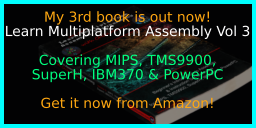
Available worldwide!
Search 'ChibiAkumas' on
your local Amazon website!
Click here for more info!

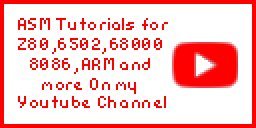
Buy my Assembly programming book
on Amazon in Print or Kindle!



Available worldwide!
Search 'ChibiAkumas' on
your local Amazon website!
Click here for more info!


Buy my Assembly programming book
on Amazon in Print or Kindle!



Available worldwide!
Search 'ChibiAkumas' on
your local Amazon website!
Click here for more info!


